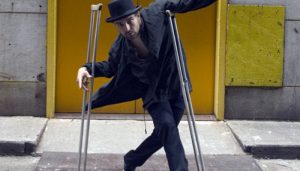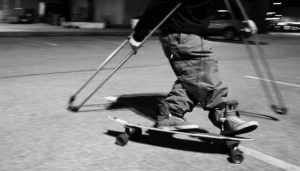“Don’t Fall” – “CrutchMaster” Bill Shannon Dances, Skateboards, Does Fall
 Dance artists often borrow from the language as well as the spirit of science, conducting “movement explorations” in the “laboratory” of the studio – or the street- and “investigating” the possibilities of the body. And many of those explorations involve setting parameters or constraints, like moving only in straight lines or working in relation to a prop. Bill Shannon, who opened at the White Box Theater last night, has contributed richly and provocatively to that conversation. His one-man “Spatial Theory” show, presented by UCSD ArtPower! with San Diego Dance Theater, runs through tomorrow night.
Dance artists often borrow from the language as well as the spirit of science, conducting “movement explorations” in the “laboratory” of the studio – or the street- and “investigating” the possibilities of the body. And many of those explorations involve setting parameters or constraints, like moving only in straight lines or working in relation to a prop. Bill Shannon, who opened at the White Box Theater last night, has contributed richly and provocatively to that conversation. His one-man “Spatial Theory” show, presented by UCSD ArtPower! with San Diego Dance Theater, runs through tomorrow night.
Shannon has a congenital deformity in both hips and needs crutches in order to stand and walk. The Pittsburgh-based artist has developed two-plus decades of solo work through investigating the movement potential of his unique body in relationship to three props, custom-designed Rocker crutches and – whee! – a skateboard.
 Swooping on the skateboard in the parking lot at the start of his show, Shannon is freedom embodied, his balance impeccable, the crutches – which he often uses individually – propelling him faster and faster. And his initial moves in the theater, just using the crutches, have a similar fluid ease; I checked to see if he was wearing sneakers with wheels on the bottom, the way his feet appeared to glide. (By the way, he can put weight on his feet; as he explains in this video, he just can’t stand or walk for any length of time without extreme pain.)
Swooping on the skateboard in the parking lot at the start of his show, Shannon is freedom embodied, his balance impeccable, the crutches – which he often uses individually – propelling him faster and faster. And his initial moves in the theater, just using the crutches, have a similar fluid ease; I checked to see if he was wearing sneakers with wheels on the bottom, the way his feet appeared to glide. (By the way, he can put weight on his feet; as he explains in this video, he just can’t stand or walk for any length of time without extreme pain.)
His work isn’t, however, about creating an illusion of effortlessness. Moves in which he twists and balances on the crutches look precarious, as a recorded voice keeps warning, “Don’t fall.” He wears a mic, and you can hear his labored breathing. Sometimes a move, for instance, a 360-degree turn on the skateboard, doesn’t work, and – explaining as he goes – he tries again. And again. By the end of the show, when he’s doing complex moves and is simply tired from what he describes as the equivalent of doing constant pushups, the strain is visible. And there are times when he does end up on the floor, and how’s he going to get up?
Shannon’s communities are both the theatrical dance world and that of street artists, and “Spatial Theory” includes sections in which he shows video from some of his street performances and discusses how he’s used them to investigate cultural responses to disability. He’s interested in the “projected narratives” that passersby create when they see him going up and down stairs using his crutches – which he happens to do with extraordinary grace – or bending to pick up a bottle from the ground.
Given the video-lecture interludes – and the fact that, at 43, Shannon doesn’t train or perform as regularly as he once did – “Spatial Theory” is a bit thin as an evening of dance. Still, there are moments of beauty and wonder, and the pleasure of encountering a mature artist who has investigated his body in the world with intelligence and depth.

Kris Eitland covers dance and theater for Sandiegostory.com and freelances for other publications, including the Union Tribune and Dance Teacher Magazine. She grew up performing many dance styles and continued intensive modern dance and choreography at the Univ. of Minnesota, Duluth, and San Diego State Univ. She also holds a journalism degree from SDSU. Her career includes stints in commercial and public radio news production.
Eitland has won numerous Excellence in Journalism awards for criticism and reporting from the San Diego Press Club. She has served on the Press Club board since 2011 and is a past president. She is a co-founder of Sandiegostory.com. She has a passion for the arts, throwing parties with dancing and singing, and cruising the Pacific in her family’s vintage trawler. She trains dogs, skis, and loves seasonal trips to her home state of Minnesota.
